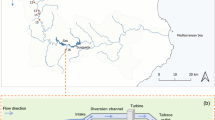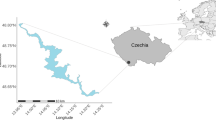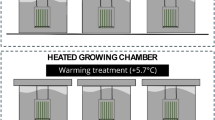Abstract
The copepod Eurytemora carolleeae dominates vernal zooplankton biomass in the Chesapeake Bay estuarine turbidity maximum (ETM) region, where it is an important prey item for larval anadromous fish. Although there have been several zooplankton studies in the Chesapeake Bay ETM focused on spring, the importance of winter zooplankton populations for establishing these vernal conditions has not been investigated. We examined the abundance, distribution, and individual sizes of E. carolleeae in winter of 2007 and 2008 and we investigated the potential impact of varying winter conditions and rising winter temperatures on Eurytemora female carbon content, egg production rate, and generation time. We found higher abundances and larger individuals in the colder 2007 than in 2008 under similar freshwater flow conditions. Empirical estimates showed that overall zooplankton productivity was higher in 2007 than in 2008. Published recruitment indices for anadromous fish including white perch and striped bass were higher in 2007 than in 2008 in the study region. Based on these findings, we hypothesize that colder conditions resulted in larger individuals and therefore increased prey biomass available to larval fish. We further hypothesize that rising winter water temperatures will negatively impact trophic transfer of primary production to copepods and ultimately to fish.







Similar content being viewed by others

References
Alekseev, Victor R., and Anissa Souissi. 2011. A new species within the Eurytemora affinis complex (Copepoda: Calanoida) from the Atlantic Coast of USA, with observations on eight morphologically different European populations. Zootaxa 2767: 41–56.
Bělehrádek, J. 1935. Temperature and living matter. Protoplasma Monographien. Vol. 8. Protoplasma Monographien. Berlin: Borntraeger.
Berk, S.G., D.C. Brownlee, D.R. Heinle, H.J. Kling, and R.R. Colwell. 1977. Ciliates as a food source for marine planktonic copepods. Microbial Ecology 4: 27–40.
Boak, A.C., and R. Goulder. 1983. Bacterioplankton in the diet of the calanoid copepod Eurytemora sp. in the Humber Estuary. Marine Biology 73: 139–149.
Bremigan, Mary T., and Roy A. Stein. 1994. Gape-dependent larval foraging and zooplankton size: implications for fish recruitment across systems. Canadian Journal of Fisheries and Aquatic Sciences 51: 913–922.
Campbell, R.G., W.M. Wagner, G.J. Teegarden, C.A. Boudreau, and E.G. Durbin. 2001. Growth and development rates of the copepod Calanus finmarchicus reared in the laboratory. Marine Ecology: Progress Series 221: 161–183.
Devreker, David, James J. Pierson, Sami Souissi, David G. Kimmel, and Michael R. Roman. 2012. An experimental approach to estimate egg production and development rate of the calanoid copepod Eurytemora affinis in Chesapeake Bay, USA. Journal of Experimental Marine Biology and Ecology 416–417: 72–83. doi:10.1016/j.jembe.2012.02.010.
Durell, E.Q., and C. Weedon. 2011. Striped bass seine survey juvenile index web page. Maryland Department of Natural Resources, Fisheries Service. http://dnr2.maryland.gov/fisheries/Pages/juvenile-index/index.aspx.
Escaravage, V., and K. Soetaert. 1993. Estimating secondary production for the brackish Westerschelde copepod population Eurytemora affinis (Poppe) combining experimental data and field observations. Cahiers De Biologie Marine 34: 201–214.
Forster, Jack, Andrew G. Hirst, and Guy Woodward. 2011. Growth and development rates have different thermal responses. The American Naturalist 178: 668–678.
Harding Jr., L.W., M.E. Mallonee, and E.S. Perry. 2002. Toward a predictive understanding of primary productivity in a temperate, partially stratified estuary. Estuarine, Coastal and Shelf Science 55: 437–463.
Hardy, J. D. 1978. Development of fishes of the mid-Atlantic Bight: an atlas of egg, larval and juvenile stages, vol. 3. Aphredoderidae through Rachycentridae. Washington, D.C.: United States Fish and Wildlife Service. Biological Services Program
Heerkloss, R.U., U. Brenning, and R. Ihlenfeld. 1990. Influence of temperature and epizoic ciliates on the growth of Eurytemora affinis (Poppe) (Calanoida, Copepoda). Wiss Z Universität Rostock 39: 12–15.
Heinle, D.R., and D.A. Flemer. 1975. Carbon requirements of a population of the estuarine copepod Eurytemora affinis. Marine Biology 31: 235–247.
Heinle, D.R., R.P. Harris, J.F. Ustach, and D.A. Flemer. 1977. Detritus as food for estuarine copepods. Marine Biology 40: 341–353.
Hirche, Hans-Jurgen. 1992. Egg production of Eurytemora affinis–effect of k-strategy. Estuarine, Coastal and Shelf Science 35: 395–407.
Hirst, A.G., and R.S. Lampitt. 1998. Towards a global model of in situ weight-specific growth in marine planktonic copepods. Marine Biology 132: 247–257.
Hirst, Andrew G., and Martin Sheader. 1997. Are in situ weight-specific growth rates body-size independent in marine planktonic copepods? A re-analysis of the global syntheses and a new empirical model. Marine Ecology: Progress Series 154: 266–165.
Huntley, Mark E., and M.D.G. Lopez. 1992. Temperature-dependent production of marine copepods: a global synthesis. American Naturalist 140: 201–242.
Jung, Sukgeun, and Edward D. Houde. 2003. Spatial and temporal variabilities of pelagic fish community structure and distribution in Chesapeake Bay, USA. Estuarine, Coastal and Shelf Science 58: 335–351. doi:10.1016/s0272-7714(03)00085-4.
Kankaala, Paula, and Sif Johansson. 1986. The influence of individual variation on length-biomass regressions in three crustacean zooplankton species. Journal of Plankton Research 8: 1027–1038.
Kimmel, David G., and Michael R. Roman. 2004. Long-term trends in mesozooplankton abundance in Chesapeake Bay, USA: influence of freshwater input. Marine Ecology: Progress Series 267: 71–83.
Kimmel, David G., Michael R. Roman, and Xinsheng Zhang. 2006. Spatial and temporal variability in factors affecting mesozooplankton dynamics in Chesapeake Bay: evidence from biomass size spectra. Limnology and Oceanography 51: 131–141.
Lee, Carol Eunmi, Jane Louise Remfert, and Yu-Mei M. Chang. 2007. Response to selection and evolvability of invasive populations. Genetica 129: 179–192. doi:10.1007/s10709-006-9013-9.
Lee, Dong-Yoon, David P. Keller, Byron C. Crump, and Raleigh R. Hood. 2012. Community metabolism and energy transfer in the Chesapeake Bay estuarine turbidity maximum. Marine Ecology: Progress Series 449: 65–82. doi:10.3354/meps09543.
Lloyd, Scott S., David T. Elliott, and Michael R. Roman. 2013. Egg production by the copepod, Eurytemora affinis, in Chesapeake Bay turbidity maximum regions. Journal of Plankton Research 35: 299–308. doi:10.1093/plankt/fbt003.
Mallin, Michael A., Hans W. Paerl, and Joseph Rudek. 1991. Seasonal phytoplankton composition, productivity and biomass in the Neuse River estuary, North Carolina. Estuarine, Coastal and Shelf Science 32: 609–623.
Martino, Edward J., and Edward D. Houde. 2010. Recruitment of striped bass in Chesapeake Bay: spatial and temporal environmental variability and availability of zooplankton prey. Marine Ecology: Progress Series 409: 213–228. doi:10.3354/meps08586.
Mauchline, J. 1998. Mauchline, John, and J. Mauchline. “The biology of calanoid copepods.”, Advances in Marine Biology 33. San Diego: Academic.
McLaren, Ian A., C.J. Corkett, and E.J. Zillioux. 1969. Temperature adaptations of copepod eggs from the arctic to the tropics. The Biological Bulletin 137: 486–493.
Merriman, D. 1941. Studies on the striped bass (Roccus saxatilis) of the Atlantic Coast. US Fish and Wildlife Service Fisheries Bulletin 50: 1–77.
Miller, Charles B., John Kenneth Johnson, and Donald R. Heinle. 1977. Growth rules in the marine copepod genus Acartia. Limnology and Oceanography 22: 326–335.
Millette, Nicole C., Diane K. Stoecker, and J.J. Pierson. 2015. Top-down control of micro-and mesozooplankton on winter dinoflagellate blooms of Heterocapsa rotundata. Aquatic Microbial Ecology 76: 15–25.
Mills, Edward L., Michael V. Pol, Ruth E. Sherman, and Teresa B. Culver. 1989. Interrelationships between prey body size and growth of age-0 yellow perch. Transactions of the American Fisheries Society 118: 1–10.
Najjar, Raymond G., Christopher R. Pyke, Mary Beth Adams, Denise Breitburg, Carl Hershner, Michael Kemp, Robert Howarth, et al. 2011. Potential climate-change impacts on the Chesapeake Bay. Estuarine, Coastal and Shelf Science 86: 1–20. doi:10.1016/j.ecss.2009.09.026.
Nichols, J.H., and A.B. Thompson. 1991. Mesh selection of copepodite and nauplius stages of four calanoid copepod species. Journal of Plankton Research 13: 661–671.
North, Elizabeth W., and Edward D. Houde. 2001. Retention of white perch and striped bass larvae: biological-physical interactions in Chesapeake Bay estuarine turbidity maximum. Estuaries 24: 756–769.
North, Elizabeth W., and Edward D. Houde. 2004. Distribution and transport of bay anchovy (Anchoa mitchilli) eggs and larvae in Chesapeake Bay. Estuarine, Coastal and Shelf Science 60: 409–429. doi:10.1016/j.ecss.2004.01.011.
Roman, Michael R., D. Van Holliday, and Lawrence P. Sanford. 2001. Temporal and spatial patterns of zooplankton in the Chesapeake Bay turbidity maximum. Marine Ecology: Progress Series 213: 215–227.
Roman, M., Xinsheng Zhang, Carey McGilliard, and William Boicourt. 2005. Seasonal and annual variability in the spatial patterns of plankton biomass in Chesapeake Bay. Limnology and Oceanography 50: 480–492.
Sanford, Lawrence P., Steven E. Suttles, and Jeffrey P. Halka. 2001. Reconsidering the physics of the Chesapeake Bay estuarine turbidity maximum. Estuaries 24: 655–669.
Secor, David H., and Edward D. Houde. 1995. Temperature effects on the timing of striped bass egg production, larval viability, and recruitment potential in the Patuxent River (Chesapeake Bay). Estuaries 18: 527–544.
Sellner, Kevin G. 1983. Plankton productivity and biomass in a tributary of the upper Chesapeake Bay. I. Importance of size-fractionated phytoplankton productivity, biomass and species composition in carbon export. Estuarine, Coastal and Shelf Science 17: 197–206.
Shideler, A.R.C. 2011. Patterns in distribution, growth, and trophodynamics of striped bass early life stages in the estuarine transition region of Upper Chesapeake Bay. Master’s Thesis: University of Maryland.
Shideler, Allison C., and Edward D. Houde. 2014. Spatio-temporal variability in larval-stage feeding and nutritional sources as factors influencing striped bass (Morone saxatilis) recruitment success. Estuaries and Coasts 37: 561–575. doi:10.1007/s12237-013-9696-y.
Shoji, J., E.W. North, and E.D. Houde. 2005. The feeding ecology of Morone americana larvae in the Chesapeake Bay estuarine turbidity maximum: the influence of physical conditions and prey concentrations. Journal of Fish Biology 66: 1328–1341.
Sirois, Pascal, and Julian J. Dodson. 2000. Influence of turbidity, food density and parasites on the ingestion and growth of larval rainbow smelt Osmerus mordax in an estuarine turbidity maximum. Marine Ecology: Progress Series 193: 167–179.
Tackx, M.L.M.L.M., P.J.M.J.M. Herman, S. Gasparini, X. Irigoien, R. Billiones, and M.H.H. Daro. 2003. Selective feeding of Eurytemora affinis (Copepoda, Calanoida) in temperate estuaries: model and field observations. Estuarine, Coastal and Shelf Science 56: 305–311. doi:10.1016/s0272-7714(02)00182-8.
Van Guelpen, Louis, Douglas F. Markle, and Diane J. Duggan. 1982. An evaluation of accuracy, precision, and speed of several zooplankton subsampling techniques. ICES Journal of Marine Science 40: 226–236. doi:10.1093/icesjms/40.3.220.
Vincent, W.F., J.J. Dodson, N. Bertrand, and J.J. Frenette. 1996. Photosynthetic and bacterial production gradients in a larval fish nursery: the St. Lawrence River transition zone. Marine Ecology: Progress Series 139: 227–238. doi:10.3354/meps139227.
Wiebe, Peter H., K.H. Burt, S.H. Boyd, and A.W. Morton. 1976. A multiple opening/closing net and environmental sensing system for sampling zooplankton. Journal of Marine Research 34: 313–326.
Wiebe, P.H., A.W. Morton, A.M. Bradley, R.H. Backus, J.E. Craddock, V. Barber, T.J. Cowles, and G.R. Flierl. 1985. New developments in the MOCNESS, an apparatus for sampling zooplankton and micronekton. Marine Biology 87: 313–323.
Wiebe, P.H., D. Allison, M. Kennedy, and G. Moncoiffé. 2015. A vocabulary for the configuration of net tows for collecting plankton and micronekton. Journal of Plankton Research 37: 21–27.
Winkler, Gesche, Julian J. Dodson, Normand Bertrand, Denis Thivierge, and Warwick F. Vincent. 2003. Trophic coupling across the St. Lawrence River estuarine transition zone. Marine Ecology: Progress Series 251: 59–73.
Wood, Robert J., and Herbert M. Austin. 2009. Synchronous multidecadal fish recruitment patterns in Chesapeake Bay, USA. Canadian Journal of Fisheries and Aquatic Sciences 66: 496–508.
Acknowledgments
We thank the captain and crew of the RV Hugh R. Sharp for their support of the research cruises. We also thank E. Houde, L. Sanford, E. North, S-Y. Chao, Y. Kim, S. Suttles, E. Kiss, and all of the members of the BITMAXII project for their assistance with the project. We are especially grateful to D. Kennedy, and G. Jahn for assistance sorting plankton samples and the anonymous reviewers. Funding for this work was by the National Science Foundation (OCE-0453905). This is UMCES contribution no. 5150.
Author information
Authors and Affiliations
Corresponding author
Additional information
Communicated by Wim J. Kimmerer
Rights and permissions
About this article
Cite this article
Pierson, J.J., Kimmel, D.G. & Roman, M.R. Temperature Impacts on Eurytemora carolleeae Size and Vital Rates in the Upper Chesapeake Bay in Winter. Estuaries and Coasts 39, 1122–1132 (2016). https://doi.org/10.1007/s12237-015-0063-z
Received:
Revised:
Accepted:
Published:
Issue Date:
DOI: https://doi.org/10.1007/s12237-015-0063-z



